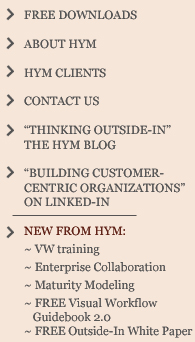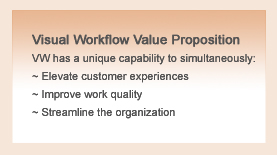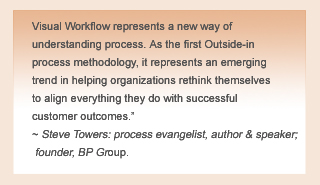

VISUAL WORKLOW
Four dimensional, Outside-In process
![]() Visual Workflow differs from traditional process approaches including Lean Six Sigma or Lean and Six Sigma individually for two core reasons:
Visual Workflow differs from traditional process approaches including Lean Six Sigma or Lean and Six Sigma individually for two core reasons:
- In VW, customers drive process design rather than just condition it.
- VW addresses all four process dimensions: what work is done; who (functionally) does it; how work is done; technology required to enable optimized process.
 Traditional process approaches devote 90% of their attention to how work is done, with but a smattering of attention paid to the other three dimensions. That’s contrary to the needs of O-I process, which focuses on the O/S (front and back office and service settings), and contrary to the requisite focus for changing companies from company-centric to customer-centric. Yes, manufacturing quality does play a role in customer centricity―but as Toyota discovered to its dismay, it’s no substitute for putting customer interests first across the entire decision-making spectrum.
Traditional process approaches devote 90% of their attention to how work is done, with but a smattering of attention paid to the other three dimensions. That’s contrary to the needs of O-I process, which focuses on the O/S (front and back office and service settings), and contrary to the requisite focus for changing companies from company-centric to customer-centric. Yes, manufacturing quality does play a role in customer centricity―but as Toyota discovered to its dismay, it’s no substitute for putting customer interests first across the entire decision-making spectrum.
![]() More reasons why VW succeeds where traditional methods falter
More reasons why VW succeeds where traditional methods falter
HYM launched Visual Workflow in 1996. Our beta was redesigning end-to-end process for a company that was a service environment melding complex front and back office activities. Two sets of Six Sigma consultants had already thrown up their hands and left, saying in effect, “Blow it up and start over again.” But VW succeeded – in its trial run. At the end of the engagement, not only did management understand what had to change and why, but staff understood equally well.
Why did Visual Workflow succeed where Six Sigma failed (and Lean would have)? It wasn’t primarily about consultant quality, although we take great pride in our work. Methodology made the difference.
| Visual Workflow | Six Sigma | Lean |
| Outside-in (customer-driven) | Inside-out (internally-driven but customer-sensitive) | Inside-out (internally-driven but customer-sensitive) |
| Produces transformational as well as incremental change | Produces incremental change |
Produces incremental change |
| Considers what work is done by who (functionally), how it’s done and enabling technology required | Focuses on how work is done | Focuses on how work is done with some consideration of the who |
| Measures impact on customers, throughput and quality | Primarily measures throughput, quality and variances | Primarily measures throughput and quality |
| Uncouples cross-functional flows from individual process | Considers them together | Stays at flow level |
| “Workflow” combines work, data and communication flows | Focus on individual process, then works up to workflow | Mostly workflow |
| Flows are contingent on decisions and policies | Flows are fixed | Flows are fixed |
| Looks for defects at flow level first, then at individual process level | Looks for defects at individual process level, then in workflow | Looks at workflow only, not data and communication flow |
| Enterprise-wide flow scanning capability | No flow scanning | Point-by-point flow scanning |
| Develops new systems architecture requirements | Does not | Does not |
| Develops software configuration requirements | Does not | Does not |
| Management and staff design process cross-functionally | Design imposed one function at a time | Requires training to participate |
| Does not require staff process training | Requires special training | Requires special training |
| Uses no process symbology or terminology | Extensive use of both | Extensive use of both |
![]() Context-sensitivity
Context-sensitivity
Please don’t read this chart as overall criticism of either Six Sigma or Lean. Both are highly capable process approaches – within their manufacturing context. Practitioners have attempted to broaden their applicability to front and back office and to service companies. However, Six Sigma often does more harm than good outside manufacturing, while Lean underperforms beyond production.
![]() The first Outside-In process approach
The first Outside-In process approach
 At the point of development, we weren’t trying to launch a new process category. But we inadvertently did. The term “Outside-In” wouldn’t surface for almost a decade, but when it emerged, VW was already there. Today, Outside-In encompasses a number of uniquely different customer-centric process design methods―all of which share one common attribute, starting with customers and working in from there, the opposite tack from traditional approaches.
At the point of development, we weren’t trying to launch a new process category. But we inadvertently did. The term “Outside-In” wouldn’t surface for almost a decade, but when it emerged, VW was already there. Today, Outside-In encompasses a number of uniquely different customer-centric process design methods―all of which share one common attribute, starting with customers and working in from there, the opposite tack from traditional approaches.
![]() The first O/S (office, service settings) process approach
The first O/S (office, service settings) process approach
In addition to being the first Outside-In process approach (or perhaps by virtue of being the first), Visual Workflow is also the first approach designed exclusively for use in O/S settings. Here’s why that’s so important.
| Office/Service vs. Manufacturing Process Design Contexts | |
| O/S context | Manufacturing context |
| Low repetition | High repetition |
| Decision-based business process | Fixed business process |
| Adaptability critical | Consistency critical |
| Hundreds of key workflows | Dozens of key workflows |
| 80 - 90% of defects up at workflow level | Majority of defects down at individual work process level |
| Majority of work activities interdependent | Many work activities independent |
| Invisible defects | Visible defects |
| Knowledge workers | Rote workers |
| Empowered staff | Compliant staff |
| Resist “external” input | Accept “external” input |
| Business process is the work | Business process guides the work |
| Fully joined workflow & information flow | Partially detached workflow & information flow |
| High-dependence on application software | Partial dependence on application software |
This chart begs the question: “Why would you use a process approach designed for the wrong context?
![]() Visual Workflow’s track record
Visual Workflow’s track record
Over the years, VW has achieved outstanding results for clients including:
- eBay
- HB Fuller
- Honeywell
- St. Vincent’s Children’s Research Hospital
- Standard Register
- Toro
- United Way
![]() Learn more
Learn more
To learn more about Visual Workflow and Outside-In process, please download these presentations:
- Introduction to Visual Workflow (PowerPoint Presentation)
- Visual Workflow Sample Maps (PowerPoint Presentation)
- Visual Workflow white paper (PDF)
©Copyright 2004-2010 High-Yield Methods - All Right Reserved
|
|
